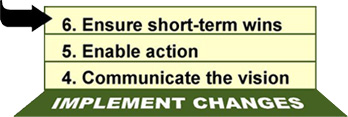How can school leaders implement changes that result in inclusive school environments?
Page 10: Ensure Short-Term Wins
 Having created an action plan, it’s now time for the guiding team to implement the strategies outlined in it. They should begin by choosing items from the plan that are easily and quickly achieved so that they create short-term wins. Short-term wins are steppingstones to greater opportunities and bigger successes, all consistent with the vision of creating an inclusive school environment. These short-term wins validate the effort and maintain a level of urgency. Typically, they should occur within three to six months because stakeholders must see evidence that their efforts are resulting in the desired change or else they might give up or even join those resistant to inclusion. To create short-term wins, the guiding team needs to:
Having created an action plan, it’s now time for the guiding team to implement the strategies outlined in it. They should begin by choosing items from the plan that are easily and quickly achieved so that they create short-term wins. Short-term wins are steppingstones to greater opportunities and bigger successes, all consistent with the vision of creating an inclusive school environment. These short-term wins validate the effort and maintain a level of urgency. Typically, they should occur within three to six months because stakeholders must see evidence that their efforts are resulting in the desired change or else they might give up or even join those resistant to inclusion. To create short-term wins, the guiding team needs to:
- Engage more stakeholders to execute each item
- Monitor progress and make results visible
- Recognize and reward stakeholders as they accomplish short-term goals
Did You Know?
While working on short-term wins, the team will work simultaneously on item(s) that take longer to accomplish.
Engage More People
 In addition to choosing items that are easily accomplished, it is important for the team to select items that encourage the participation of other stakeholders. Involving as many stakeholders as possible in the completion of the items outlined in the action plan facilitates more buy-in. They can easily accomplish this if each team member recruits two to three other individuals to participate in the effort of creating an inclusive school environment.
In addition to choosing items that are easily accomplished, it is important for the team to select items that encourage the participation of other stakeholders. Involving as many stakeholders as possible in the completion of the items outlined in the action plan facilitates more buy-in. They can easily accomplish this if each team member recruits two to three other individuals to participate in the effort of creating an inclusive school environment.
To recruit willing participants, the guiding team should describe the items in the action plan and discuss what is involved. The team might utilize the communication strategies used earlier in this change process or they might brainstorm additional strategies. For example, the team may formally discuss the action plan at faculty meetings or PTA meetings, or they may discuss it more informally during lunch. Ultimately, the goal is to get willing participants from all stakeholder groups, including community members, involved in the process.
Pearl Sims relates an experience she had when leading a school change and advises school leaders to recruit rather than ask for volunteers (time: 0:30).
Pearl Sims, PhD
Former Director, Leadership Development Center
Vanderbilt University

Transcript: Pearl Sims, PhD
It is important that you remember that not all volunteers are necessarily the ones you want. Let me tell you a story quickly. I was in the process of leading a change in a school when I asked in a faculty meeting if someone would be willing to volunteer. Of course, the person that volunteered was one of the people that had most resisted the changes I was trying to make in the school. He saw this as an opportunity to build an even bigger platform for his resistance, so be careful as you recruit volunteers.
Make Progress Visible
Once school personnel and other stakeholders have started working on the items in the action plan, the individual(s) responsible for overseeing these items need to chart or graph progress toward the goal so that gains are visible. The chart or graph needs to be posted in a high-traffic area where it is sure to be seen (e.g., outside main office door, teacher’s lounge). This helps to maintain stakeholder’s motivation throughout the change process.
Reward Individuals
 Even under the best of circumstances, individuals will not follow a vision forever, so the guiding team needs to keep the stakeholders motivated. When progress reaches the criteria stated in the action plan, the team should take time to celebrate. Acknowledging school personnel’s hard work and success is crucial to maintaining momentum for the long-term commitment of creating an inclusive environment. As items in the action plan are completed, the guiding team should be sure to reward those involved. Doing so will keep school staff motivated and encourage others to join the effort. Some of the ways the guiding team can recognize and reward stakeholders’ efforts include:
Even under the best of circumstances, individuals will not follow a vision forever, so the guiding team needs to keep the stakeholders motivated. When progress reaches the criteria stated in the action plan, the team should take time to celebrate. Acknowledging school personnel’s hard work and success is crucial to maintaining momentum for the long-term commitment of creating an inclusive environment. As items in the action plan are completed, the guiding team should be sure to reward those involved. Doing so will keep school staff motivated and encourage others to join the effort. Some of the ways the guiding team can recognize and reward stakeholders’ efforts include:
- Offering praise and words of encouragement
- Sharing data that demonstrates overall progress toward inclusion
- Providing an occasional tangible reward (e.g., pizza at a staff meeting)
- Encouraging them to present at faculty meetings and professional conferences
- Acknowledging their successes in school newsletters
- Presenting teacher-of-the-week awards
Although rewarding the individuals responsible for short-term wins is essential, keep in mind that short-term wins can be seductive. It is tempting to declare the battle won based on early successes, but doing so can have grave consequences. It is important to remind stakeholders that creating an inclusive school environment is a multi-year effort with continuous incremental improvements. One primary reason for change-effort failure at this stage is that victory is declared too soon. Because premature victory celebrations can quash momentum and allow the forces of tradition to regain their hold, it is important to:
- Remind personnel that gains will be gradual
- Emphasize that this is a learning process for everyone
- Maintain a collaborative approach
For Your Information
It is important to keep in mind that schools may not always achieve their short-term goals. In such cases, it is best to look for the silver lining. When communicating with stakeholders, the team should:
- Focus on the lessons learned and how to improve their efforts to meet a revised or new goal
- Avoid assigning blame
- Encourage stakeholders to persevere even though gains will be gradual
- Remind stakeholders that the only way to fail is to quit
 Ms. Lawrence knows that an early victory in the change process would give her team a clear idea of what the new CMS will look like. She also realizes that having the team accomplish one of the action items is important as a counter to critics and resistors who may otherwise impede the progress of the initiative. With the guiding team, Ms. Lawrence examines the action plan with the aim of answering one question, “What can we do that will have immediate results?” The team chooses to work on the two items from the action plan listed below. Click on each to view the rationale.
Ms. Lawrence knows that an early victory in the change process would give her team a clear idea of what the new CMS will look like. She also realizes that having the team accomplish one of the action items is important as a counter to critics and resistors who may otherwise impede the progress of the initiative. With the guiding team, Ms. Lawrence examines the action plan with the aim of answering one question, “What can we do that will have immediate results?” The team chooses to work on the two items from the action plan listed below. Click on each to view the rationale.
|
Rationale: The team knows that for other parts of the plan to work, the teachers and other instructional staff need time to collaborate––a key component of building an inclusive environment. For this reason, the extra forty-five minutes per day mandated by the district can be used for common planning time. This altered master schedule for the upcoming fall semester will demonstrate the guiding team’s commitment to creating an inclusive environment. The school is gaining a valuable resource—common planning time—that will not cost any money (something in short supply at the school these days). |
|
Rationale: The guiding team knows that if an inclusive environment where all students are better readers is to become a reality, the students will need to receive a lot of support along the way. A volunteer base of local university students and senior citizens is available to begin in the next few weeks to monitor small reading groups. According to the school’s reading expert, more time reading strongly correlates to improved reading skills. In addition, the extra people in the school will demonstrate the team’s commitment to involving community members in the vision of the school. This will cost the school very little money, but it has the potential to add resources that can immediately benefit the students. |
Activity
Again, think back to the action plan you created earlier in the module. Choose two items that will likely ensure short-term wins. Explain why you chose them and why each will yield positive results quickly.
